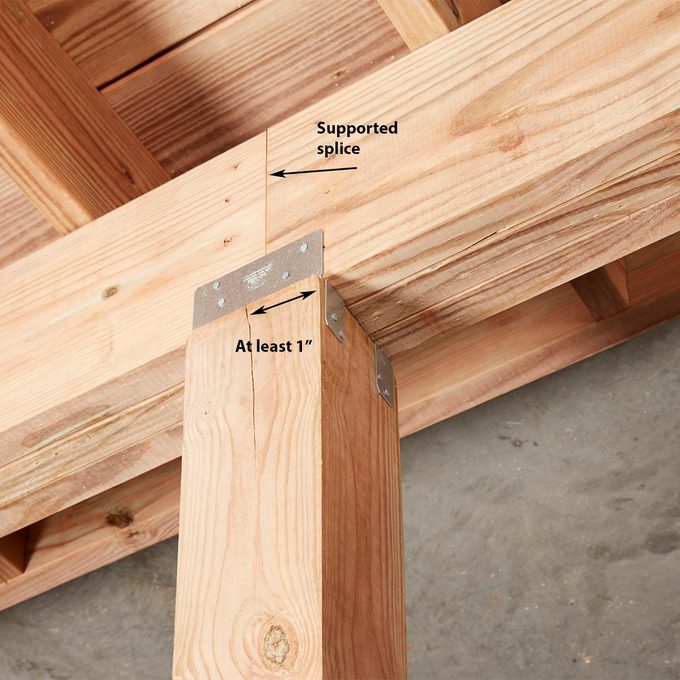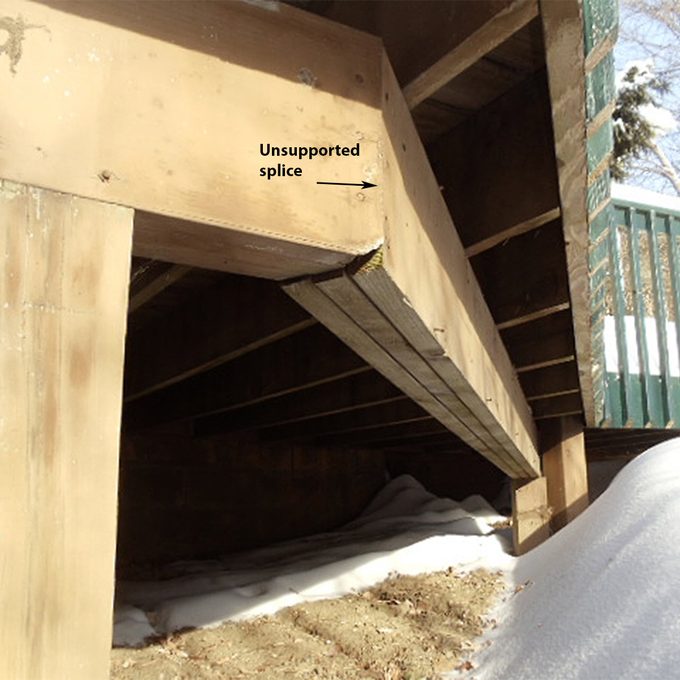There’s no sense installing a beam that’s not supported by a post. But that’s what one deck builder did. Maybe the builder assumed that attaching the beam to the end of another beam would do the trick. WRONG!
How To Splice Beams Properly
A beam splice involves joining two separate beam sections to create a longer, continuous structural member. This connection—made using bolts, welds, or specialized plates—is commonly used in wood, steel and concrete structures to extend span length, transfer loads effectively and enhance overall stability.
Splices in beams should be supported by a post or structural column of some sort. The post or column should rest on a footing that meets local building code requirements. The beams should be connected to the post with an approved metal connector. Beams should be supported by at least one inch of solid wood over posts.
Here’s what you need to know:
Why is splicing necessary in construction?
Beam splicing supports loads better and enhances strength when compared to a single beam. Connecting two beams is specifically useful when one beam isn’t long enough to offer the desired distance.
Splicing makes beams more manageable. They can be loaded, transported and installed more easily. Handling one long, heavy beam can prove to be difficult and cumbersome. Safe beam splice practices ensure structural integrity throughout the construction process.
Another advantage of joining beams is that it enables engineers to create more intricate, complex structural designs without compromising on strength. Some examples include atriums, vaulted ceilings, curved roofs and other suspended structures.
In addition to this, beam sections can be altered on-site to obtain non-standard geometries for special structures.
On This Page
Tools and Materials Needed for Beam Splicing
Preparing the beams and joining them involves actions such as cutting, drilling and fastening. You will need a set of specific tools and materials to do this.
Tools for an accurate beam splice
- Wrenches are used to secure bolts as per the specifications.
- Welding machines are used to build strong, permanent joints between beam sections, especially in a steel beam splice where durability is imperative.
- Drill machines are required to drill holes in steel, wood or concrete beams accurately.
- Measuring tape and laser levels help secure beam alignment and splice placement correctly.
- Cranes are stationed to lift and hold the hefty beam sections while splicing.
- Clamps are a must to secure beams and plates during welding.
- Safety equipment such as gloves, welding masks, helmets and harnesses are imperative for the safety of workers.
- Grinding and cutting tools facilitate the process of trimming and assembling beam edges for a better fit during splicing.
Materials for wood and steel beam splice
- Splice plates are flat steel plates used to join and strengthen the beam joints, especially critical in a steel splice to ensure structural integrity
- High-strength bolts and nuts help fasten beams and splice plates together properly. This is even more important when learning how to splice wood beams
- Welding rods or electrodes are a must to link splices together.
- Grout or epoxy is used to fill gaps and strengthen the splice connections in concrete beams
- Shims are slender plates needed to conform and align beam heights
- Protective coatings are usually anti-corrosion paints or primers to shield the spliced area, mainly in steel structures

Step-by-Step Guide to Splicing Beams Safely
A beam splice is a highly skilled task that requires precision, safety and a set of standard processes. Here are six steps you can follow to splice them correctly. This needs to be tweaked further according to the material you are working with.
Step 1: Assess load and structural requirements
Start by calculating the load by taking into account the bending moment, shear force and axial force. Choose beam splicing methods based on construction conditions, load types and cost. You can opt for bolted, welded or a hybrid connection. Put together all the splice design drawings like splice plate dimensions, bolt arrangement and weld requirements. You can get this vetted with the construction team and obtain feedback.
Step 2: Cut beams to fit and align properly
The next step starts with ensuring the beam ends are fully ready. You can undertake milling to obtain smooth splicing surfaces. You need to get the splice plates manufactured as per dimensions, material properties and design specifications. After this, high-precision equipment can be used to make all the bolt holes. Pay attention to the hole placement and diameter while doing this.
Step 3: Align the splice plates
First, position the beam sections end-to-end. Use clamps, a level, or laser calibration equipment to perfectly align the beams. Check the splice plates, bolt holes and weld bevels once again before proceeding. Mark and drill holes carefully according to measurements to maintain safe beam splice practices throughout the process.
Step 4: Focus on the connections
While connecting splices, you can either insert bolts and tighten them or weld around the plate edges as per design specifications. Another option is to do both. Pre-tighten the bolts and follow up with welding. Make sure you secure bolts in the correct sequence and according to the specified torque values.
Step 5: Inspect and test the splice
Before you do the final checks, look for gaps in case of concrete splices and fill them up. In a steel beam splice, drilling high-precision bolt holes is essential to prevent misalignment or stress concentrations. Check if the alignment is accurate, bolts are tightened, and welding quality is up to the mark. The splice has to meet all the structural design criteria. You can also do an ultrasonic test to ensure the welds don’t have any cracks or defects.
Step 6: Cleaning and finishing touches
Clean the area properly and carry out periodic inspections, especially for outdoor or load-bearing structures. You can apply fireproof coatings to the splice area if required.

Common Mistakes to Avoid When Splicing Beams
Working with beams necessitates both accuracy and know-how to ensure the strength and safety of the structure. Let’s look at some frequent mistakes that can be prevented with proper planning and safe beam splice practices.
Overlooking load calculations
You need to include both the loads (permanent and transient) and take into account deflection limits, which are the maximum amount of bending allowed under a load. Otherwise, you might end up with smaller beams that break down soon or deflect too much.
Aligning beam ends improperly
If you fail to align beam ends correctly, it can result in structural vulnerability, unequal load distribution and even safety hazards. Precision and adherence to safe beam splice practices are key to maintaining structural performance.
Inappropriate bolt spacing or undersized holes
Inaccurate bolt spacing and undersized holes can incapacitate beam connections due to stress. This, in turn, usually results in premature material and bolt failure. A proper bolt arrangement is needed to ensure the beam splice is strong under load.
Splicing in high-stress zones
Beam splicing in high-stress zones, such as near connections or cantilever ends (a structural element that is fixed at one end and extends on the other), can lead to failure. Increasing splice length can help prevent this.
Inadequate cleaning and maintenance
Regular upkeep is pivotal to sustaining the strength and longevity of beam connections. If splice areas are not cleaned properly and monitored for corrosion or breakdowns periodically, they can lead to unstable joints.
Inaccurate beam spacing
Failing to measure beam spacing properly can cause uneven load distribution and frail structural support. Spacing beams too far apart can weaken floors, and spacing them too close can lead to material waste.
FAQ
What is the best way to splice a wooden beam?
The best way to splice a wood beam depends on the application and design needs. Some popular mechanisms include mortise, through bolts, tenon joints, scarf joints and steel plate connections. In order to achieve good strength and stability, place splices away from areas of maximum stress.
How do you calculate the load capacity for a spliced beam?
To calculate the load capacity for a spliced beam, you need to consider the bending moment, shear forces and the capacity of the splice itself. You can start by calculating the beam’s bending capacity and then move on to shear and splice connection capacity. Ensure you also check for capacity limits and take into account design considerations.
Sources:
- Steel Pro Peb: “What is Beam Splice, Why, Where, When and How”
- American Institute of Steel Construction (AISC): “Splice Design”
- ClearCalcs: “Choosing the Best Material for Beam Design: Timber, Steel or Concrete?”
- Codinter: “Beam Cutting: A Complete Guide”


















